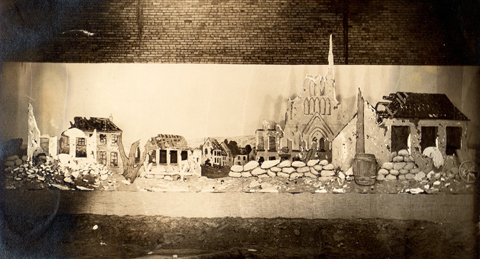Between 1914 and 1918, millions of soldiers inhabited the trenches that lined the battlefields of the Western Front. First-hand accounts of trench life offer stark descriptions of filth, disease, injury and death. Apart from being cold, wet and hungry for days, even months on end, soldiers faced near constant bombardment. “Thirteen months and more had some of us sat in trenches,” recalled UC alumnus Corporal R. A. Utley, “taking what the Germans chose to give us in the shape of shells and sniper’s bullets.”
While nothing could prepare recruits for the grim realities of trench warfare, the University of Toronto did what it could to equip its student soldiers for what was coming. Beginning in 1914, the military used Hart House (which was under construction throughout the war) as a training ground. Recruits marched in the Great Hall, the Royal Flying Corps set up workshops in the gymnasium, and the Military Hospitals Commission Command trained medical personnel, including women nurses and rehabilitation specialists, in what are now the Debates and Music Rooms. When wounded soldiers began returning home, large portions of the building were devoted to rehabilitation.
Under the command of Lieutenant-Colonel Vincent Massey (who would become Canada’s first native-born Governor General), students also trained under combat-like conditions in the unfinished basement that would later become the Hart House theatre. Lieutenant Lawren Harris, a member of the musketry staff (who would go on to fame as a Group of Seven artist), used his paintbrushes to create an imitation Belgian village that spanned one side of the room.
The shell-shattered replica depicts the main thoroughfare of a village after a German attack. The foreground is dominated by broken trees, rubble and sandbags that seem ineffectual against the destruction. Almost defiantly, a cathedral towers above the scene while smaller houses lie in ruins.
A trench accommodating up to 20 men faced the village. Trainees passed messages along the trench and life-like German marionettes appeared in the windows of bombed out buildings. Student snipers popped up from behind sandbags and fired at the moving targets. “It is very real,” one observer reported. “Nothing seemed lacking but the noise and roar of battle to transfer me to a sector of the Western Front.”
In what must have seemed a quaint memory to those facing the genuine roar of battle, similar scenes were staged across Toronto in the early years of the war. High Park and the CNE were likewise transformed into training sites, complete with trenches and faux German targets.

The Globe reported that throngs of Torontonians turned out at the Exhibition grounds to inspect mock trenches that were “modelled on the latest kinds in use in Flanders and France.” Soldiers, many of whom were Varsity men, performed battles, bayonetting sacks painted to resemble Kaiser Wilhelm II, Crown Prince Wilhelm and others as a large crowd of onlookers cheered.
Hart House officially opened on Remembrance Day, 1919, exactly a year after the end of the war. On this occasion Vincent Massey remarked, “The bricks and mortar are but the bones, the community must provide the spirit.” Throughout the war, the soldiers, students, faculty, staff and volunteers who passed through Hart House personified Massey’s call to action by demonstrating a spirit of sacrifice, devotion and deep commitment to service.
Recent Posts
U of T’s 197th Birthday Quiz
Test your knowledge of all things U of T in honour of the university’s 197th anniversary on March 15!
Are Cold Plunges Good for You?
Research suggests they are, in three ways
Work Has Changed. So Have the Qualities of Good Leadership
Rapid shifts in everything from technology to employee expectations are pressuring leaders to constantly adapt






